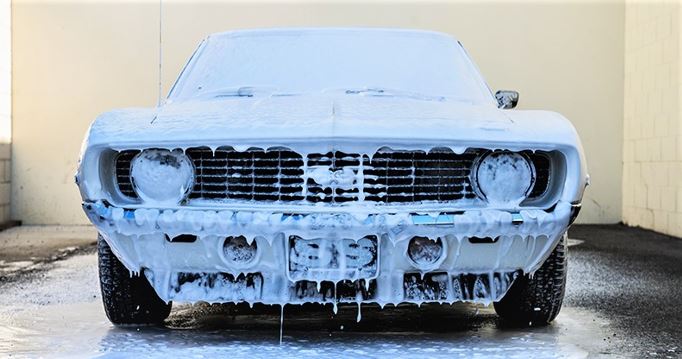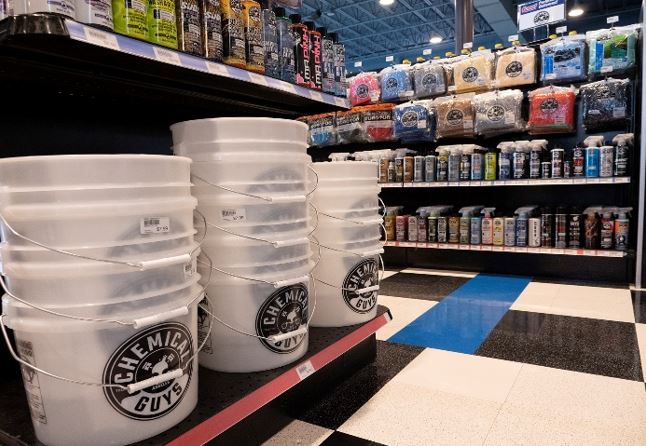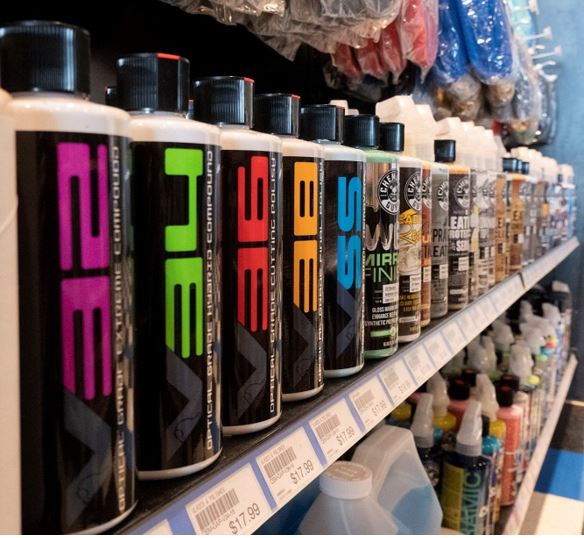
National Car Care Month is here and hopefully soon we will be cruising the town and headed to our favorite car shows.
Now is the time to get that ride shined up and looking its best!
Many of us roll our cars out of the garage and give them a good wash, a fresh wax job, add some wheel and tire shine and a little detailer spray, and off we go.
But let’s slow down and take a deeper look at this routine.
Years of performing this same procedure can lead to wax build-up which can then result in a loss of paint clarity.
Add in environmental effects like tree sap, UV rays, construction zone sediment, and road dust, you may have a vehicle that’s more tarnished than you realize.
Let’s look closer at methods and procedures for removing paint contaminates and bringing back that original shine your car or truck deserves—the type of deep shine that glimmers under street lights and mirrors sunrays.
These methods might seem a little intimidating at first, but with some instruction and video demonstrations from our friends at Chemical Guys you will be able to confidently achieve proper paint correction for incredible depth and shine.
Preparation

There are a plethora of car soaps available and we all have our favorites.
Most soaps are gentle and designed to protect your wax and sealant coats.
To remove all of that buildup you will need to look for soap with a little more power like Chemical Guy’s Clean Slate Cleanser Wash. This soap is a deep surface cleanser that breaks down layers of grime and releases layers of old wax and sealants in preparation for a full paint detail.
Once all of the wax is removed, the next step is to use a clay bar with a lubricator, the shearing action of a clay bar leaves behind a smooth surface free of microscopic contaminants.
There are several methods for claying. Classic clay bars are comprised of a soft resin compound. Newer versions provide contaminate removal in the form of a cleansing, clay mitt, or clay pad with each style having advantages and disadvantages. Whichever you choose, be sure to follow the recommended procedure for using the product.
…
Polishing

Once the paint surface is completely stripped of wax and microscopic debris, it’s time to restore it by removing minor scratches and oxidization with a polisher.
This is where some people get skittish, and for good reason. The wrong polisher or technique can damage, burn, and even remove paint, especially on the edges.
Selecting the right polisher should be proportional to your skill level and usage.
Rotary polishers spin on a single axis with a forced rotation.
These polishers are faster and more aggressive performers that are great for heavy blemishes. These polishers require training and experience to learn the right approach and handle effectively, but with the right skill set, they produce fast, professional results.
Dual-action polishers have a twin-axis, which spins on one axis, with a second axis orbiting around the first.
These polishers require more time to produce the same results as a single-axis polisher, but are much more forgiving, defaulting to orbit-only (oscillation) when there’s too much friction which prevents paint damage.
These polishers are an excellent choice for novices.
Whatever polisher you decide to add to your car detailing arsenal, be sure to take the time to understand how it operates on a practice surface.
When choosing polishing pads and compounds it’s always wise to start lighter than heavier. You can always increase the aggressiveness of the compound as needed.
You can become proficient in paint correction after spending a little time practicing the correct technique and familiarizing yourself with the “feel” of the machine.
Then you will be the person answering questions and offering advice after everyone sees how amazing your ride looks.
Q&A — Everything you Need to Know About Polishing
…
Check out the full line of Chemical Guys along with a huge selection of many of your favorite detailing supplies from Mothers, 3M, Meguiar’s, Jay Leno’s Garage, and Summit Racing detailing products.

[…] National Car Care Month is here and hopefully soon we will be cruising the town and headed to our favorite car shows. Now is the time to get that ride […] Read full article at http://www.onallcylinders.com […]
For those worried about polishing a “normal” vehicle, with a little practice, and, the right equipment and products, it’s actually very easy. Now, imagine what my family, a.k.a. the pit crew, goes through when we detail my 2006 Freightliner Classic XL semi tractor every spring and fall. I spec’d “The Mistress” (as my wife named her years ago) and took delivery in late 2005. Now, after over 14 years AND 1.5 MILLION miles, she’s both a working truck and show truck. Obviously, when you spend over $130k just on the initial purchase of something that provides your livelihood, you have to take care of it. Accessories have been added over the years of course, but, the original Saphire Black paint (special order) still shines like a diamond because of the care it has received.